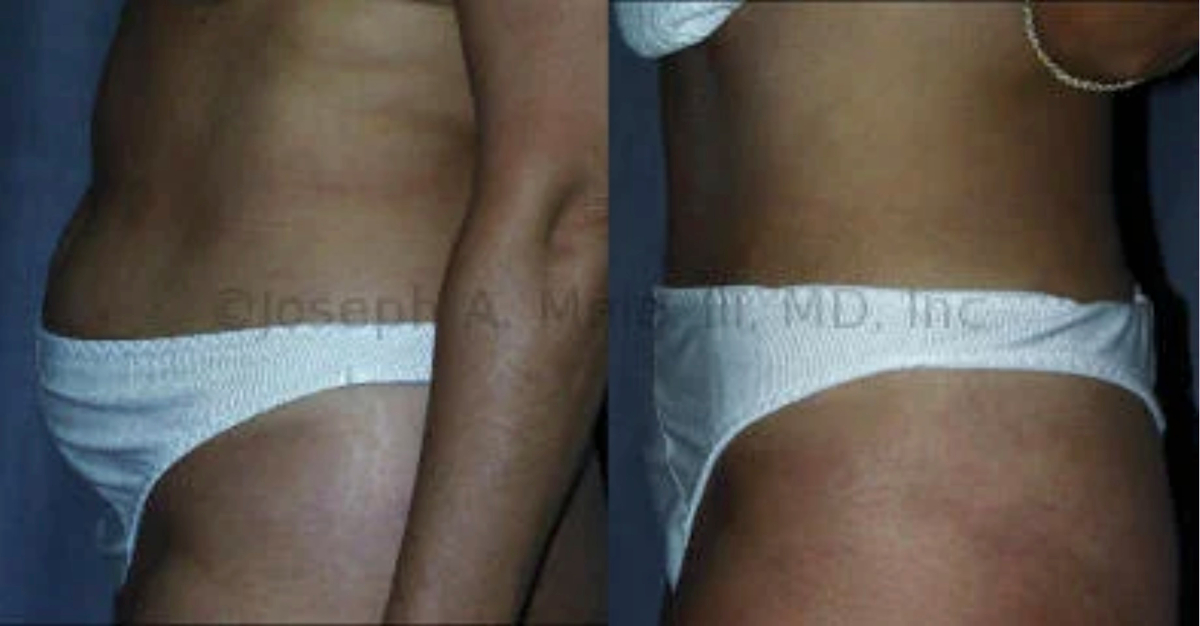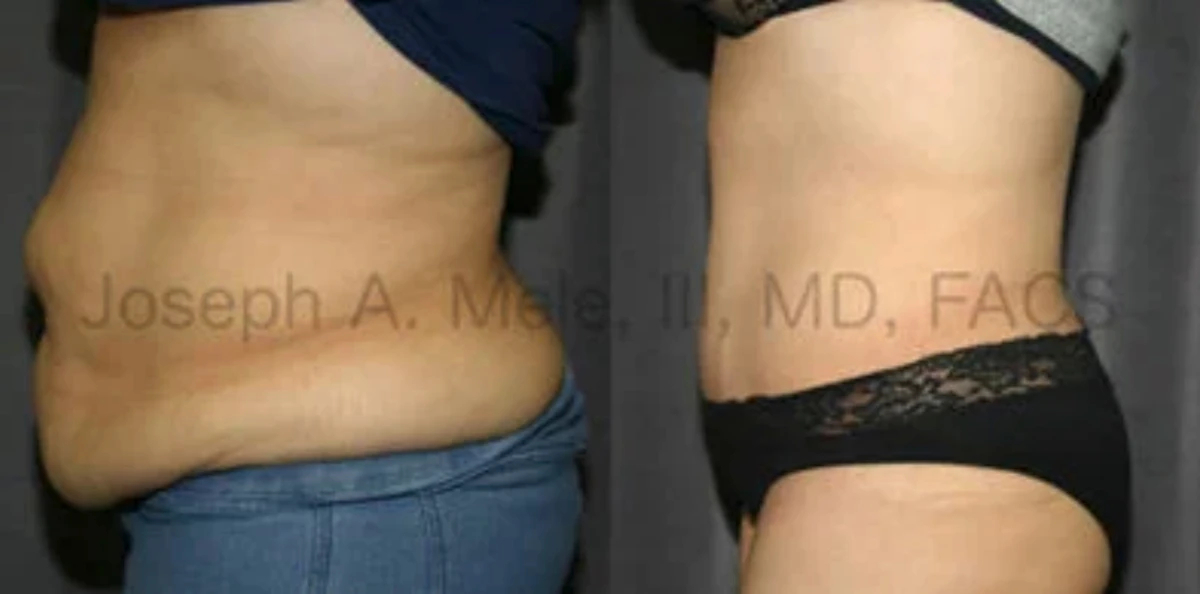A Tummy Tuck, medically known as Abdominoplasty, is a surgical procedure designed to remove excess skin and fat from the abdomen while tightening the underlying muscles to create a smoother, firmer abdominal profile. It is popular among individuals who have experienced significant weight loss, pregnancy, or aging, which can leave loose skin and weakened abdominal muscles. This comprehensive post explores the risks, benefits, procedure, alternatives, goals, limitations and recovery process associated with a Tummy Tuck. While this provides a detailed resource for those considering this transformative surgery, it cannot substitute for an in-person consultation with an experienced plastic surgeon.
Goals of a Tummy Tuck

This amount of lower abdominal protrusion can occur even after weight loss and exercise. Abdominoplasty was the final step to a flatter belly.
The primary goals of a tummy tuck are both cosmetic and functional, aimed at improving the appearance and, in some cases, the functionality of the abdominal area. These include:
- Improved Abdominal Contour: The procedure removes excess skin and fat, resulting in a flatter, more toned abdomen.
- Tightened Abdominal Muscles: For patients with diastasis recti (separation of abdominal muscles, often post-pregnancy), a tummy tuck repairs and tightens these muscles, enhancing core strength and stability.
- Enhanced Confidence and Body Image: Many patients report improved self-esteem and comfort in clothing after the procedure.
- Correction of Functional Issues: In some cases, removing excess skin can alleviate skin irritation, rashes, or discomfort caused by overhanging skin folds.
- Support for Weight Loss Maintenance: For those who have lost significant weight, a tummy tuck can remove residual loose skin, helping maintain a healthier body image and lifestyle.
While the procedure is highly effective for these goals, it is not a weight-loss solution or a substitute for a healthy diet and exercise. Patients should have realistic expectations and understand that results vary based on individual anatomy and lifestyle factors.
Benefits of a Tummy Tuck
The benefits of a tummy tuck extend beyond aesthetics, offering physical, emotional and functional improvements. Key benefits include:
- Cosmetic Enhancement: A tummy tuck creates a smoother, flatter abdomen, improving the body’s overall proportions. It is particularly effective for patients with stubborn skin and fat that do not respond to diet or exercise.
- Muscle Repair: By suturing separated abdominal muscles, the procedure can improve posture, reduce back pain and enhance core strength, especially for post-pregnancy patients.
- Removal of Excess Skin: For individuals post-weight loss or pregnancy, removing loose, sagging skin can prevent hygiene issues, infections, or discomfort caused by skin folds.
- Long-Lasting Results: With a stable weight and healthy lifestyle, results can last for many years, making it a durable solution compared to non-surgical treatments.
- Psychological Boost: Many patients experience increased confidence, improved body image and greater comfort in social or intimate settings after surgery.
- Customizable Procedure: Tummy tucks can be tailored (e.g., mini, full, or extended abdominoplasty) to address specific concerns, ensuring personalized outcomes.
These benefits make Abdominoplasty appealing for those seeking significant abdominal improvement, but they must be weighed against potential risks and limitations.
Risks of a Tummy Tuck
As with any major surgery, a tummy tuck carries risks, some of which are common to surgical procedures and others specific to abdominoplasty. While complications are relatively rare when performed by a board-certified plastic surgeon, patients should be fully informed. Potential risks include:
- Infection: Surgical sites may become infected, requiring antibiotics or, in rare cases, additional surgery. Proper wound care and hygiene minimize this risk.
- Bleeding and Hematoma: Excessive bleeding during or after surgery can lead to a hematoma (a collection of blood under the skin), which may require drainage or surgical intervention.
- Scarring: A tummy tuck leaves a permanent scar, typically low on the abdomen, hidden by underwear or swimwear. However, some patients may develop hypertrophic or keloid scars, which are raised or thickened.
- Seroma: Fluid accumulation under the skin (seroma) is a common complication, often managed with drains or aspiration.
- Poor Wound Healing: Smokers, diabetics, or those with compromised immune systems may experience delayed healing or wound separation, increasing scarring or infection risk.
- Blood Clots: Deep vein thrombosis (DVT) or pulmonary embolism (PE) are rare but serious risks, particularly in patients with prolonged immobility post-surgery.
- Nerve Damage: Temporary or, rarely, permanent numbness or altered sensation in the abdominal area may occur due to nerve disruption during surgery.
- Asymmetry or Unsatisfactory Results: Uneven contours, residual fat, or asymmetry may occur, sometimes requiring revision surgery.
- Anesthesia Risks: General anesthesia carries risks like allergic reactions, respiratory issues, or cardiovascular complications, though these are rare in healthy patients.
- Fat Necrosis: In rare cases, fatty tissue beneath the skin may die, causing firm lumps or irregularities.
To mitigate these risks, patients should choose an experienced, Board Certified Plastic Surgeon, follow all pre- and post-operative instructions, disclose medical history, avoid smoking, vaping or medications that increase bleeding risk or interfere with anesthesia or wound healing.
Abdominoplasty Procedure Details

Tummy Tuck can be combined with Liposuction to improve the proportions of the sides and back too.
A Tummy Tuck is typically performed under general anesthesia and takes 2–5 hours, depending on the extent of the surgery. The procedure varies based on whether it is a full, mini, extended or fleur-de-lis tummy tuck, but the general steps for a full Abdominoplasty are as follows:
- Consultation and Planning: Before surgery, the surgeon evaluates the patient’s health, discusses goals and marks the abdominal area to guide incisions. Patients may need to stop certain medications, quit smoking and undergo lab tests.
- Anesthesia: General anesthesia is administered to ensure the patient is unconscious and pain-free during the procedure.
- Incision: The surgeon makes a horizontal incision above the pubic area, typically from hip to hip and a second incision around the navel for a full tummy tuck. The length and shape of the incision depend on the amount of skin to be removed.
- Muscle Repair: The surgeon lifts the skin and fat to access the abdominal muscles, suturing separated or weakened muscles (diastasis recti) to tighten the abdominal wall.
- Excess Tissue Removal: Excess skin and fat are trimmed away, and the remaining skin is pulled taut over the abdomen.
- Navel Repositioning: For a full tummy tuck, the navel is repositioned to align with the new abdominal contour, creating a natural appearance.
- Liposuction (Optional): Some surgeons use liposuction to remove additional fat deposits and refine the waistline or flanks.
- Closure: The incisions are closed with sutures, and drains may be placed to prevent fluid buildup. The area is bandaged, and a compression garment is applied to reduce swelling.
- Recovery Room: The patient is monitored in a recovery room for a few hours before being discharged (outpatient) or admitted for an overnight stay (inpatient).
Mini Tummy Tucks involve a smaller incision (because there is less skin to remove) and focus on the lower abdomen, while Extended Tummy Tucks and Lower Body Lifts address the flanks and lower back for more extensive contouring. The Fleur-de-Lis Tummy Tuck adds a vertical scar down the front of the abdomen to remove excessive skin from the center of the belly.
Alternatives to a Tummy Tuck
For those hesitant about surgery or seeking less invasive options, several alternatives may address similar concerns, though they often have limitations compared to Abdominoplasty:
- Liposuction: This procedure removes localized fat deposits through small incisions but does not address loose skin or muscle separation. It is ideal for patients with good skin elasticity and minimal excess skin.
- Non-Surgical Skin Tightening: Devices like radiofrequency (e.g., Thermage) or ultrasound (e.g., Ultherapy) can stimulate collagen production to tighten mild skin laxity. Results are subtle and less dramatic than a tummy tuck.
- CoolSculpting: This non-invasive fat-freezing technique reduces fat in targeted areas but does not tighten skin or muscles. It suits patients with small fat pockets and no significant skin laxity.
- Exercise and Diet: Strength training and a healthy diet can improve muscle tone and reduce fat, but they cannot eliminate excess skin or repair separated muscles.
- Body Contouring Garments: Compression garments or shapewear can temporarily smooth the abdomen but offer no permanent change.
- Weight Loss Programs: For patients with significant fat, medically supervised weight loss may reduce abdominal bulk, but loose skin may remain, necessitating surgery later.
Each alternative has trade-offs. Non-surgical options are less risky and require minimal downtime but often yield modest results. Consulting a plastic surgeon can help determine the best approach based on individual needs.
Limitations of a Tummy Tuck
While Abdominoplasty is highly effective, it has limitations that patients should understand:
- Not a Weight-Loss Solution: The procedure is designed for contouring, not significant fat removal. Patients should be at or near their ideal weight before surgery.
- Permanent Scarring: Scars are inevitable, though they fade over time and are placed discreetly. Some patients may find Limited Impact on Stretch Marks: Stretch marks on the upper abdomen may remain if not removed during skin excision.
- Results Vary: Outcomes depend on factors like skin elasticity, body type and lifestyle. Significant weight gain or pregnancy post-surgery can compromise results.
- Not a Substitute for Fitness: While muscle repair improves core strength, a tummy tuck does not replace exercise for overall health.
Revision May Be Needed: Some patients require touch-up procedures for optimal results, especially if healing issues or asymmetry occur.
Patients with unrealistic expectations may be disappointed, even when a good surgical result is obtained, so thorough consultation is critical.
Recovery After a Tummy Tuck

Abdominal diastases, separation of the abdominal muscles, cause central projection of the abdomen. A Tummy Tuck can repair the diastases and improve appearance.
Physical Recovery from a Tummy Tuck typically takes 6–12 weeks, with most patients resuming light activities within 2–3 weeks. The process involves physical and emotional adjustments, and adherence to post-operative care is essential for optimal results. Key aspects include:
- Immediate Post-Op (1–3 Days): Patients experience swelling, bruising and discomfort, managed with prescribed pain medication. Drains, if used, collect fluid and are typically removed within 1–2 weeks. A compression garment is worn to reduce swelling and support healing.
- First Two Weeks: Rest is critical, with no heavy lifting or strenuous activity. Walking is encouraged to prevent blood clots. Patients may need help with daily tasks, as bending or stretching can strain incisions. Most return to desk jobs after 10–14 days.
- Weeks 3–6: Swelling and soreness decrease, and patients can resume light activities like driving or walking. Strenuous exercise, heavy lifting, or core workouts are avoided. Scars begin to fade but remain red or raised.
- 6–12 Weeks: Most patients resume normal activities, including exercise, with surgeon approval. Swelling may persist for months, but the final contour emerges. Scars continue to mature over 1–2 years.
- Long-Term Care: Maintaining a stable weight, eating a balanced diet and avoiding smoking support lasting results. Follow-up visits ensure proper healing and address concerns.
Tips For Tummy Tuck Recovery:
- Follow wound care instructions to speed healing and prevent infection.
- Stay hydrated and eat protein-rich foods to aid tissue repair.
- Avoid nicotine (smoking and vaping), as it impairs healing.
- Attend all follow-up appointments to monitor progress.
Emotional Recovery is also important, as body image adjustments and temporary discomfort can affect mood. Support from family, friends or a counselor can help.
Tummy Tuck Consultations
Abdominoplasty is a powerful plastic surgery procedure and the gold standard that offers significant cosmetic and functional benefits for those with excess abdominal skin, fat, or muscle separation. It can enhance appearance, boost confidence and alleviate physical discomfort, but it comes with risks, costs and a substantial recovery period. By understanding the procedure, its alternatives, and its limitations, patients can make informed decisions and achieve satisfying outcomes.
While I have tried to hit the important highlights, consulting an experienced Board Certified Plastic Surgeon, maintaining realistic expectations and committing to post-operative care are critical for success.
For those considering a Tummy Tuck, thorough research and open communication with a medical professional will pave the way for a transformative experience. To learn if a tummy tuck is the right choice for you in the San Francisco Bay Area, call (925) 943-6353 and schedule your personal consultation appointment.
Previous Post